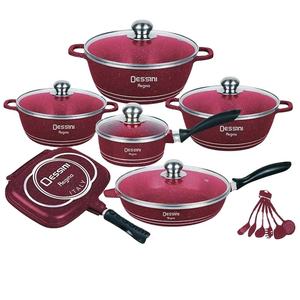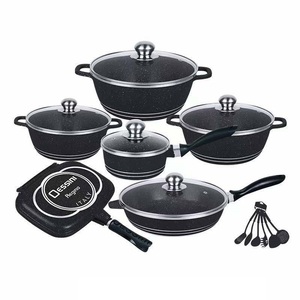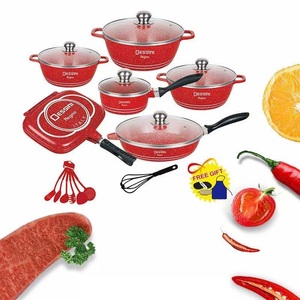(15324 products available)








































































































































































































Die cast cookware is a durable and versatile cooking tool that can be used for a variety of cooking needs. Made from die-cast aluminum, this type of cookware is known for its long-lasting and heat-retaining properties. One of the unique features of die-cast cookware is that it can be used on almost any cooking surface, including induction cooktops. This makes it a convenient option for those with different kitchen setups. The durability of die cast cookware allows it to withstand daily use and last for many years, making it a cost-effective investment in the long run. Additionally, die-cast cookware is easier to clean and maintain, often being dishwasher safe and resistant to staining and corrosion. For those who prioritize health-conscious cooking, die-cast cookware is often free from harmful chemicals like PFOA and PTFE.
Die cast cookware refers to cooking pots, pans, and other kitchen tools made through die casting. This process involves pouring molten metal into a mold to create the desired shape. There are several types of die-cast cookware available in the market today.
Casting pots:
Die-cast cooking pots are made from durable materials like aluminum or zinc alloy. These materials are melted and poured into molds shaped like the desired pot. This process results in a strong, long-lasting product with excellent heat retention and distribution. Pots are essential for boiling, cooking sauces, making soups, and steaming. They come in various sizes to fit different needs. Some common types of pots include stockpots, saucepans, and Dutch ovens. People find die-cast cookware, including pots, more useful because they are compatible with all types of cooking surfaces.
Frying pans and skillet pans:
Frying pans and skillet pans are other types of die-cast cookware. These are primarily used for frying, but they are versatile enough for various cooking methods, including sauteing and baking. Die-cast frying pans and skillet pans are durable and have smooth surfaces that provide a better cooking experience. They are compatible with all cooking surfaces.
Die-cast dutch oven:
A Dutch oven is a heavy pot with a tight-fitting lid, and it's excellent for slow-cooking, braising, baking, and stewing. A die-cast Dutch oven retains heat, so meals are cooked evenly. They work well on all cooking surfaces, including induction.
Die-cast casserole:
Die-cast casserole cookware is designed for baking dishes. They are great for making casseroles, stews, and baked pasta dishes. They keep heat well, making them ideal for long, slow cooking.
A grill pot means a grill pan with a lid. It's a 2-in-1 cookware. So, the design of the grill pot includes the design of the grill pan and the pot. Grill pots have ridged bottoms, and some have a flat side. The ridged side gives grill marks, and the flat side is for grilling. The design of the pot is similar to that of a skillet or saucepan. Some grill pots have two handles, while others have one. The lid may also have a handle. Grill pots come in various sizes, so users can choose according to their needs.
Some grill pans have a ridged design on the bottom, while some have a flat design. The ridged design makes grill marks on the food. The flat design is for grilling specific food items, such as pancakes. Grill pans are made in various sizes and shapes, including square, round, and rectangular. They are compatible with all cooktops, including induction cooktops.
There are two parts to the design of Dutch ovens: the base and the lid. The base is thick and heavy and has a flat bottom. It has two looped handles on the side for carrying. The lid is tight-fitting and has a small knob or handle on top. Dutch ovens come in various colors, so users can choose according to their kitchen's theme. Some Dutch ovens have enamel coating, while others have a plain metal finish.
The base of the saucepan is thick and made of metal. It has a long handle on one side and a lid that fits tightly on top. Saucepan designs are made in various colors and finishes, such as stainless steel, copper, or non-stick coating.
Residential Cooking:
Die-cast cookware like frying pans, saucepans, and Dutch ovens are used in homes for everyday cooking tasks ranging from frying, sautéing, and searing to slow cooking and braising. Their ability to retain heat makes them ideal for home cooking.
Commercial Kitchens:
Many restaurants and catering businesses use die-cast cookware because it is durable and provides consistent results. Chefs can perform tasks such as frying, making sauces, and stewing dishes for customers with saucepans and skillets.
Outdoor Cooking:
Die-cast cooking tools work well for camping, hiking, or grilling in parks. Items like portable Dutch ovens and skillets can be used over an open flame or charcoal grill, allowing people to enjoy their favorite dishes even when they are outside.
Food Production and Processing:
Die-cast cookware is used in some parts of the food production and processing industry. For example, certain machines may have die-cast components to produce ready-to-eat meals or processed foods that require frying or cooking.
Cooking Demonstrations and Classes:
Die-cast cookware is often used in cooking demonstrations at culinary schools, food festivals, or community events. Participants can clearly understand how to use various cooking tools and techniques from the instructors.
Special Dietary Food Preparation:
Die-cast cookware is ideal for preparing certain foods for people with special dietary needs. For instance, people who need to control their blood pressure may be advised to reduce their sodium intake and thus require tools that allow for low-sodium cooking methods.
For business buyers, choosing die cast cookware involves considering the following factors:
Material Selection:
Choose durable and heat-resistant die cast materials like aluminum or zinc for long-lasting cookware.
Manufacturing Process:
Select cookware produced using die casting for precise shapes and smooth surface finishes, ensuring consistent quality and performance.
Durability and Longevity:
Opt for items with the durability of die castings, which can withstand rigorous use and have a longer lifespan, reducing the need for replacements.
Thermal Conductivity:
For efficient cooking, choose materials with excellent thermal conductivity, such as aluminum die castings, which ensure even heat distribution and faster cooking times.
Surface Finish:
Select items with protective coatings or treatments on the surface to enhance resistance to scratches, corrosion, and staining for easier cleaning and maintenance.
Food Safety Standards:
Ensure that die cast cookware meets food safety standards to meet the business customers' health requirements and ensure that no harmful substances are leached into the food.
Performance Testing:
Conduct performance tests on prototypes to evaluate factors such as heat distribution, durability, and ease of use before large-scale purchase to ensure the cookware meets the desired performance standards.
Cost Considerations:
Consider the overall cost, including the initial purchase cost, production efficiency, and potential maintenance or replacement costs over the cookware's lifespan, to ensure a cost-effective investment.
Supplier Reputation:
Choose suppliers with a good reputation who can provide reliable die cast cookware and after-sales support to ensure product quality and provide timely technical support and warranty services.
Q1: What are the benefits of using die cast cookware?
A1: The benefits of using die cast cookware include superior heat retention and distribution, durability, versatility, and healthier cooking.
Q2: Can die cast cookware be used on all types of cooktops?
A2: Die cast pots and pans can be used on all types of cooktops, including induction cooktops.
Q3: Is die cast cookware safe to use?
A3: Yes, die cast cookware is generally safe to use. It is made from food-grade materials and is free from harmful chemicals.
Q4: How should die cast cookware be cleaned?
A4: Die cast cookware can be cleaned by hand using mild soap and water or in the dishwasher. However, it is recommended to check the manufacturer's instructions for specific cleaning guidelines.
Q5: Can die cast cookware be used in the oven or microwave?
A5: Die cast cookware can be used in the oven, but it is essential to check the manufacturer's guidelines for the maximum oven-safe temperature. Die cast cookware is not suitable for use in the microwave.